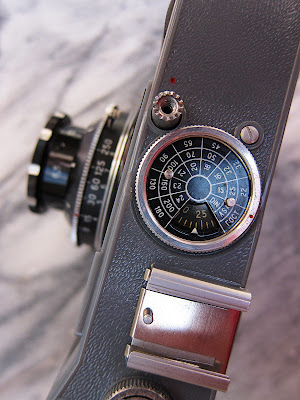There have been a handful of great designers who have put their names to cameras. Of all the designers that I wish had designed a camera, Raymond Loewy the father of American industrial design (he was actually French), would be at the top of my list. He did in fact design a consumer camera for Ansco, which although nice, doesn't have the style of, say, his $100, 000 pencil sharpener.
Raymond Loewy's name has always added value to a product, sometimes his name was used by advertisers without him knowing. The newspaper advert below states "Beautiful streamlined design by Raymond Loewy". I wish it were true but it's a myth dreamed up to sell a product.
 The art deco design is by two Englishmen. That wonderful shape was created by the brilliant poster artist Tom Purves. The job of making it work was cleverly done by Alfred Croger Mayo. And, if I may say so, Raymond Loewy couldn't have done it better. The name PURMA comes from the founders names, PURves and MAyo.
The art deco design is by two Englishmen. That wonderful shape was created by the brilliant poster artist Tom Purves. The job of making it work was cleverly done by Alfred Croger Mayo. And, if I may say so, Raymond Loewy couldn't have done it better. The name PURMA comes from the founders names, PURves and MAyo.Let me introduce you to the Purma Special!
The Purma is the work of great minds. The modernist design wouldn't have looked out of place in Fritz Langs Metropolis. It's made of black bakelite, that's grooved like a 78rpm disc. The lever to cock the shutter and the indent for the shutter button have the same profiles as 1930's airliners, in fact the shape of the body is borrowed from a pair of wings.
There is no design compromise on this camera, knobs and buttons would have ruined those modernist lines and a lens is un-thinkable. So all the controls are either blended in, or like the shutter, recessed. The most troublesome bit, the lens is hidden (except for when you need to take a photograph) behind a discreet bakelite lens cap. On removing the cap, the lens telescopes out.
 The shutter was the brainchild (it's patented), of Alfred Croger Mayo, it is ingenious if odd. The shutter speed control, which selects the three speeds (slow, medium and fast), is invisible. To change speed, you turn the camera clockwise to the vertical position for fast, turn it 180 degrees for medium and tun it horizontal for slow (it helps if you're a bendy cartoon character). Somewhere inside the camera gravity does it's job and the speeds do indeed change, you can hear a metallic noise! There is no visible indication, you have to have faith. Because the photos are square, it makes no difference if the camera is held vertical or horizontal, clever eh!
The shutter was the brainchild (it's patented), of Alfred Croger Mayo, it is ingenious if odd. The shutter speed control, which selects the three speeds (slow, medium and fast), is invisible. To change speed, you turn the camera clockwise to the vertical position for fast, turn it 180 degrees for medium and tun it horizontal for slow (it helps if you're a bendy cartoon character). Somewhere inside the camera gravity does it's job and the speeds do indeed change, you can hear a metallic noise! There is no visible indication, you have to have faith. Because the photos are square, it makes no difference if the camera is held vertical or horizontal, clever eh! Aperture and focusing are fixed, no worries there.
Aperture and focusing are fixed, no worries there.All this design, but what do the photos look like? Well I have to be honest and tell you that I haven't used my Purma to take a photo, but I will one day. The 127 film is readily available, in the UK you can buy it from AG Photographic and in the US from The Frugal Photographer. There's an active user group on Flickr, some of whom make stunning photographs with the old Purma.
I'm sorry Mister Loewy didn't have a hand in the design of this camera. If you want one of his original designs, he did design the Lucky Strike logo which is still available and affordable, but sadly not this camera.















































